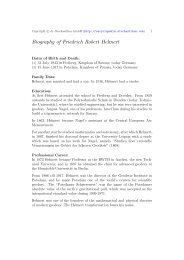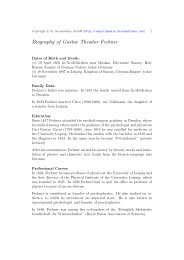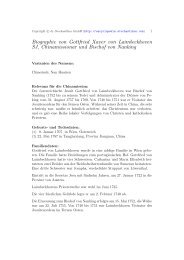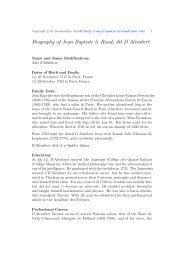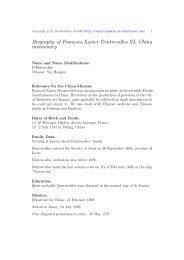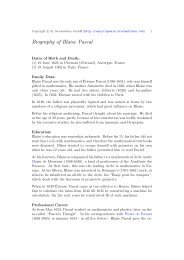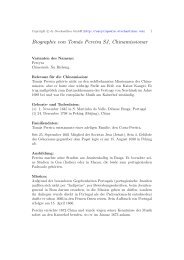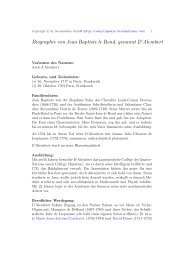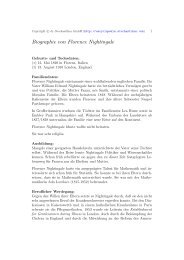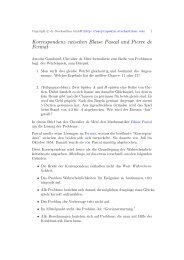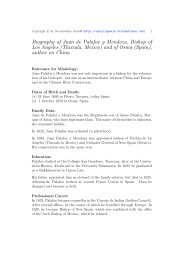Biographie von Christiaan Huygens
Biographie von Christiaan Huygens
Biographie von Christiaan Huygens
Erfolgreiche ePaper selbst erstellen
Machen Sie aus Ihren PDF Publikationen ein blätterbares Flipbook mit unserer einzigartigen Google optimierten e-Paper Software.
Copyright c○ by Stochastikon GmbH (http://encyclopedia.stochastikon.com) 1<br />
<strong>Biographie</strong> <strong>von</strong> <strong>Christiaan</strong> <strong>Huygens</strong><br />
Varianten des Namens:<br />
Christian Hugens<br />
Huyghens.<br />
Geburts- und Todesdaten:<br />
(∗) 14. April 1629 in Den Haag, Niederlande<br />
(†) 8. Juli 1695 Den Haag, Niederlande<br />
Familiendaten:<br />
<strong>Christiaan</strong> <strong>Huygens</strong> Vater war der Diplomat, Schriftsteller und Dichter Constantijn<br />
<strong>Huygens</strong> (1596-1687), in der holländischen Literatur berühmt wegen<br />
seiner Gedichte. Die Familie stand seit zwei Generationen in Diensten der<br />
Statthalter der niederländischen Generalstaaten, der Oranier. Im Kampf der<br />
Niederlande gegen Ludwig XIV. spielte der Vater <strong>Huygens</strong> eine wichtige Rolle.<br />
Constantijn <strong>Huygens</strong> hatte außerdem wissenschaftliche Kontakte mit Marin<br />
de Mersenne (1588-1648) und René Descartes (1596-1650).<br />
Ausbildung:<br />
<strong>Christiaan</strong> <strong>Huygens</strong> wurde zunächst <strong>von</strong> Privatlehrern erzogen. 1645 ging er<br />
zum Studium des Rechts und der Mathematik bei Frans van Schooten (1615-<br />
1660) nach Leiden, wo er auf eine Diplomatenkarriere vorbereitet werden<br />
sollte. Daneben studierte er auch klassische griechische Mathematik und die<br />
Methoden <strong>von</strong> Viète, Descartes und Fermat. Im März 1647 begann <strong>Huygens</strong><br />
mit dem Jurastudium am Collegium Auriacum in Breda; daneben setzte<br />
er seine Studien in Mathematik fort. Doch mit dem Tod des Statthalters<br />
Willem II <strong>von</strong> Oranien im Jahre 1650 entfiel für <strong>Huygens</strong> die Möglichkeit des<br />
diplomatischen Dienstes, für den er ausgebildet worden war.<br />
Nach seinen Studien in Breda arbeitete <strong>Huygens</strong>, <strong>von</strong> kurzen Besuchen in<br />
Paris und London abgesehen, in Den Haag, <strong>von</strong> seinem Vater unterstützt,<br />
als Privatgelehrter über Probleme der Mathematik, Mechanik, Astronomie,<br />
Pendeluhren, optische Instrumente und Linsen. 1655/56 entdeckte er den<br />
Ring des Saturn, 1656 erfand er die Pendeluhr. Mitte der 60 Jahre wurde er<br />
bereits als führender Mathematiker seiner Zeit angesehen.
Copyright c○ by Stochastikon GmbH (http://encyclopedia.stochastikon.com) 2<br />
Beruflicher Werdegang:<br />
Im Jahre 1666 begab sich <strong>Huygens</strong> nach Paris, nachdem ihm Louis XIV<br />
für den Fall, daß er in Paris leben würde, eine Pension angeboten hatte.<br />
Dazwischen reiste jedoch immer wieder nach Den Haag. Der Angriff <strong>von</strong> Louis<br />
XIV auf die Niederlande bereitete ihm keine Probleme, widmete er ihm doch<br />
1673 sein Buch über die Pendeluhren. Nach 1681 kehrte er seiner Krankheit<br />
wegen und wegen der sich verschlechternden Situation für Protestanten in<br />
Frankreich (Widerruf des Ediktes <strong>von</strong> Nantes) nicht nach Paris zurück. In<br />
den Jahren bis zu seinem Tode 1695 veröffentlichte er eine Reihe <strong>von</strong> Werken.<br />
Schon bei seinem ersten Aufenthalt in Frankreich war <strong>Huygens</strong> mit Stochastik<br />
in Berührung gekommen, als er vom Briefwechsel zwischen Blaise Pascal<br />
(1623-1662) und Pierre de Fermat (1601-1665) hörte, in dem beide über Probleme<br />
des Glücksspiels diskutierten. Um das Problem der Chance zu lösen,<br />
wollte <strong>Huygens</strong> dabei die <strong>von</strong> Viète und Descartes entwickelte neuen Mathematik<br />
einsetzen. So war <strong>Huygens</strong> der erste, der Algebra zur Bestimmung<br />
<strong>von</strong> Chancen einsetzte, während bis dahin Mathematik für das Gebiet der<br />
Chance für ungeeignet angesehen wurde. Alle <strong>von</strong> Pascal, Fermat und auch<br />
<strong>Huygens</strong> gelösten Probleme lassen sich auf das Problem der Punkte und des<br />
Würfelspiels zurückführen, wobei es beim Glücksspiel nicht um einen einzigen<br />
Wurf, sondern um eine ganze Serie <strong>von</strong> Versuchen geht. Pascal ermutigte<br />
ihn, ein Buch über die Wahrscheinlichkeit zu schreiben.<br />
<strong>Huygens</strong> gehörte zu den Wissenschaftlern, die maßgeblich zur Ausprägung<br />
des neuzeitlichen Weltverständnisses beitrugen, die jedoch außerhalb der Universitäten<br />
arbeiteten. <strong>Huygens</strong> Traktat De ratiociniis in ludo aleae ist das<br />
erste gedruckte Werk über Stochastik.<br />
Wichtige Veröffentlichungen:<br />
• Œuvres complètes, 22 vols., diverse Ausgaben und Reprints (The Hague,<br />
Amsterdam 1888-1950; 1973-1978), dabei vol. 14: Calcul des probabilités<br />
(La Haye 1920) pp. 1-179 (mit verschiedenen Fassungen und Geschichte).<br />
• Der Titel der ersten Fassung über das Glücksspiel lautete “Van Rekeningh<br />
in Speelen van Geluck” (On the reckoning at Games of Chance)<br />
(1656). <strong>Huygens</strong> Lehrer van Schooten ermöglichte ihm die Veröffentlichung<br />
dieser Abhandlung in lateinischer Sprache Libellus de Ratiociniis<br />
in Ludo Aleae als Appendix <strong>von</strong> Schootens Exercitationum Mathematicarum<br />
libri quinque. Quibus accedit Tractatus de ratiociniis in aleae
Copyright c○ by Stochastikon GmbH (http://encyclopedia.stochastikon.com) 3<br />
ludo (Leiden 1656-1657; London 1714) (elektronische Ressource), repr.<br />
in: Œuvres vol. 14, zusammen mit einer französischen Übersetzung,<br />
englische Übersetzung in: John Arbuthnot, Of the Laws of Chance, or,<br />
A Method of Calculation of the Hazards of Game (London 1692, London<br />
1738) (da<strong>von</strong> elektronische Ressource), mit Anmerkungen im ersten<br />
Buch der Ars conjectandi (Basel 1713) <strong>von</strong> Jakob Bernoulli (1654-1705),<br />
deutsch zusammen mit dem Werk Bernoullis übersetzt <strong>von</strong> R. Haussner:<br />
Wahrscheinlichkeitsrechnung (Leipzig 1899), Neuausgabe (Michigan<br />
2006), teilweise italienische Übersetzung: P. Dupont, Clara Silvia<br />
Rorero (transl.), “Il trattato “De ratiociniis in ludo aleae” di <strong>Christiaan</strong><br />
<strong>Huygens</strong> con le “Annotationes” di Jacob Bernoulli (“Ars conjectandi”,<br />
Parte 1)”, Memorie della Accademia delle Scienze di Torino (5) 8<br />
(1984) pp. 1-258.<br />
• Horologium oscillatorium, sive de motu pendulorum ad horologia aptato<br />
demonstrationes geometricae (Paris 1673), repr. (London 1966, Bruxelles,<br />
1966, 1973, auch bei der B.Nat., Paris. Spätere Editionen in: Christiani<br />
Hugenii Zulichemii Opera varia, 4 vols. (Leiden 1724) pp. 15-192,<br />
andere Ausgabe: Christiani Hugenii Zulichemii opera mechanica, geometrica,<br />
astronomica et miscellenea, 4 vols. in 2 (Leiden 1751), dann<br />
in: Œuvres complètes, vol. 18 (1934) pp. 68-368, englisch: <strong>Christiaan</strong><br />
<strong>Huygens</strong>’ the pendulum clock, or, Geometrical demonstrations concerning<br />
the motion of pendula as applied to clocks (Ames 1986), deutsch:<br />
Die Pendeluhr (Leipzig 1913), italienisch: L’orologio a pendolo (Firenze<br />
1963), französisch: L’Horloge oscillante (Bordeaux 1980).<br />
• Traité de la lvmière Où sont expliquées Les causes de ce qui luy arrive<br />
Dans la Reflexion, & dans la Refraction. Et particulierement Dans<br />
l’etrange Refraction Dv Cristal D’Islande (Leiden 1690; Bruxelles 1967),<br />
englisch: Treatise on Light in which are explained the causes of that<br />
which occurs in reflexion, & in refraction; and particularly in the strange<br />
refraction of Iceland crystals (New York 1962), deutsch: Abhandlung<br />
über das Licht (Leipzig 1890; Darmstadt 1964; Thun 2000), auch als<br />
Teil <strong>von</strong>: Isaac Newton, Mathematical principles of natural philosophy<br />
(Chicago 1996). 1988).<br />
• Kosmotheōros, sive de terris caelestibus, earumque motu, conjecturae<br />
(Hagae 1698; Frankfurt, Leipzig 1704; Prag, ca. 1759), englisch: The<br />
Celestial worlds discover’d (London 1722; London 1968; Ann Arbor<br />
1999-), französisch: Nouveau traité de la pluralité des mondes (Amsterdam<br />
1718), deutsch: Herrn Christian Hügens Weltbeschauer, oder
Copyright c○ by Stochastikon GmbH (http://encyclopedia.stochastikon.com) 4<br />
vernünftige Muthmaßungen, daß die Planeten nicht weniger geschmükt<br />
und bewohnet seyn, als unsere Erde (Zürich 1767).<br />
• Christiani Hvgenii à Zvlichem Const. F. Horologivm (Den Haag 1658),<br />
bzw.: Horologium oscillatorium sive de motu pendulorum ad horologia<br />
aptato demonstrationes geometricae (Paris 1673; Wiesbaden 1966;<br />
Düsseldorf 1977), neue Ausgaben: A. Heckscher, A. Oettingen (eds.),<br />
Horologium oscillatorium: die Pendeluhr (Leipzig 1913), englisch: Richard<br />
J. Blackwell (transl. with notes), <strong>Christiaan</strong> <strong>Huygens</strong>’ the pendulum<br />
clock, or Geometrical demonstrations concerning the motion of<br />
pendula as applied to clocks (Ames 1986).<br />
• Theoremata de vi centrifuga et motu circulari demonstrata (1705), deutsch:<br />
Felix Hausdorff (ed.), Christian <strong>Huygens</strong>’ nachgelassene Abhandlungen:<br />
Über die Bewegung der Körper durch den Stoss: Über die Centrifugalkraft<br />
(Leipzig 1921).<br />
• Nouveau traité de la pluralité des mondes (Paris 1702; Amsterdam 1718;<br />
Den Haag 1724).<br />
• Vier Abhandlungen über die Kreismessung: Archimedes, <strong>Huygens</strong>, Lambert,<br />
Legendre: Über die gefundene Größe des Kreises (Niederwalluf b.<br />
Wiesbaden 1971).<br />
• Rudolf Rasch (ed.), <strong>Christiaan</strong> <strong>Huygens</strong>: Le cycle harmonique (Rotterdam<br />
1691), Novus cyclus harmonicus (Leiden 1724): with Dutch and<br />
English translations (Utrecht 1986).<br />
• Briefwechsel zwischen Leibniz, Hugens van Zulichem und dem Marquis<br />
de l’Hospital (Berlin 1849; 1971).<br />
• Leibnizens und <strong>Huygens</strong> Briefwechsel mit Papin: nebst einer <strong>Biographie</strong><br />
Papin’s und einigen zugehörigen Briefen und Actenstücken (1881;<br />
Vaduz 1996).<br />
• Rienk H. Vermij, “An unpublished autograph by <strong>Christiaan</strong> <strong>Huygens</strong>:<br />
his letter to David Gregory of 19 January 1694”, Annals of Science 49<br />
(1992) pp. 507-523.
Copyright c○ by Stochastikon GmbH (http://encyclopedia.stochastikon.com) 5<br />
Wissenschaftliche Ehrungen:<br />
1663 als erster ausländischer Wissenschaftler zum Ehrenmitglied der Royal<br />
Society of London ernannt.<br />
1666 <strong>von</strong> Colbert nach Paris berufen, wo er eines der ersten Mitglieder der<br />
neugegründeten Académie des Sciences wurde.<br />
Referenzen und weiterführende Literatur:<br />
• Charles Coulston Gillespie (ed.), Dictionary of scientific biography, vol.<br />
VI (New York 1972) pp. 597-613.<br />
• Sondernummer der Revue d’histoire des sciences, mit Titel: “Expérience<br />
et raison”, la science chez <strong>Huygens</strong> (1629-1695), t. 56 (Paris 2003), darin:<br />
Fabien Chareix, “La découverte des lois du choc par <strong>Christiaan</strong> <strong>Huygens</strong>”,<br />
pp. 15-58; André Charrak, “<strong>Huygens</strong> et la théorie musicale”, pp. 59-78; Patricia<br />
Radelet-de Grave, “L’Univers selon <strong>Huygens</strong>, le connu et l’imaginé”,<br />
pp. 79-112; Gianfranco Mormino, “Le rôle de Dieu dans l’oeuvre scientifique<br />
et philosophique de <strong>Christiaan</strong> <strong>Huygens</strong>”, pp. 113-133; Gianfranco Mormino,<br />
Fabien Chareix, “Bibliographie huguenienne”, pp. 153-190.<br />
• Cornelis Dirk Andriesse, Titan kan niet slapen: een biografie van <strong>Christiaan</strong><br />
<strong>Huygens</strong> (Amsterdam 1993).<br />
• Cornelis Dirk Andriesse, <strong>Huygens</strong>: the man behind the principle (Cambridge<br />
2005).<br />
• Friedrich Barth, “Die ersten Lösungen der fünf Probleme des <strong>Christiaan</strong><br />
<strong>Huygens</strong>, nacherzählt in moderner Sprache”, Der Mathematikunterricht 54<br />
(2008) pp. 19-42.<br />
• A.E. Bell, Christian <strong>Huygens</strong> and the Development of Science in the Seventeenth<br />
Century (London 1947).<br />
• Harmen P. Blok (ed.), <strong>Huygens</strong>’ principle, 1690-1990: theory and applications;<br />
proceedings of an International Symposium The Hague/ Scheveningen<br />
November 19-22, 1990 (Amsterdam 1992).<br />
• H.J.M. Bos, “The influence of <strong>Huygens</strong> on the formation of Leibniz’ ideas”,<br />
in: Albert Heinekamp (ed.), Leibniz à Paris (1672-1676): symposium de la<br />
G.-W.-Leibniz-Ges. (Hannover) et du Centre National de la Recherche scientifique<br />
(Paris) à Chantilly, t. 1 (Studia Leibnitiana 17) (Wiesbaden 1978) pp.<br />
59-68.<br />
• Hendrik Jan Maarten Bos, M.J.S. Rudwick (eds.), Studies on <strong>Christiaan</strong><br />
<strong>Huygens</strong>: invited papers from the Symposium on the life and work <strong>Christiaan</strong><br />
<strong>Huygens</strong>, Amsterdam, 22-25 August 1979 (Lisse 1980).<br />
• H.J.M. Bos, “Recognition and wonder: <strong>Huygens</strong>, tractional motion and some<br />
thoughts on the history of mathematics”, Tractrix 1 (1989) pp. 3-20.
Copyright c○ by Stochastikon GmbH (http://encyclopedia.stochastikon.com) 6<br />
• William Browne, Christiani Hugenii Libellus de Ratiociniis in Ludo Aleae.<br />
Or, the Value of all Chances in Games of Fortune, Cards, Dice, Wagers,<br />
Lotteries etc. Mathematically Demonstrated (London 1714).<br />
• Henri L. Brugmans, Le séjour de Christian <strong>Huygens</strong> à Paris et ses relations<br />
avec les milieux scientifiques français, suivi de son Journal de voyage à Paris<br />
et à Londres (Paris 1935).<br />
• E.M. Bruins, “Computation of logarithms by <strong>Huygens</strong>”, Janus 65 (1978)<br />
pp. 97-104.<br />
• E.M. Bruins, “On the history of logarithms: Bürgi, Napier, Briggs, de<br />
Decker, Vlacq, <strong>Huygens</strong>”, Janus 67 (1980) pp. 241-260.<br />
• J.Z. Buchwald, “Experimental investigations of double refraction from <strong>Huygens</strong><br />
to Malus”, Archive for History of Exact Science 21 (1979/80) pp. 311-<br />
373.<br />
• C.B. Burch, “<strong>Huygens</strong>’ pulse models as a bridge between phenomena and<br />
<strong>Huygens</strong>’ mechanical foundations”, Janus 68 (1981) pp. 53-64.<br />
• Vere Clairbone Chappel, Seventeenth-century natural scientists (New York<br />
1992).<br />
• Fabien Chareix, La philosophie naturelle de <strong>Christiaan</strong> <strong>Huygens</strong> (Paris<br />
2006).<br />
• Elart <strong>von</strong> Collani (ed.), Defining the Science of Stochastics (Lemgo 2004).<br />
• C.A. Crommelin, “Sur l’attitude de <strong>Huygens</strong> envers le calcul infinitésimal<br />
et sur deux courbes intéressantes du meme savant”, Simon Stevin 31 (1956)<br />
pp. 5-18.<br />
• Lorraine Daston, Classical Probability in the Enlightenment (Princeton<br />
1988).<br />
• Alfonsina D’Elia, <strong>Christiaan</strong> <strong>Huygens</strong>: una biografia intellettuale (Milano<br />
1985).<br />
• Fokko Jan Dijksterhuis, “<strong>Christiaan</strong> <strong>Huygens</strong>”, Centaurus 2 (1953) pp.<br />
265-282.<br />
• Fokko Jan Dijksterhuis, Lenses and waves: <strong>Christiaan</strong> <strong>Huygens</strong> and the<br />
mathematical science of optics in the seventeenth century (Dordrecht 2004).<br />
• Steffen Ducheyne, “<strong>Huygens</strong>’s understanding of trajectory: ’via media’ between<br />
Galileo and Newton”, Historia Scientiarum 17 (2007) pp. 1-19.<br />
• Steffen Ducheyne, “Huygnes’s understanding of trajectory ’via media’ between<br />
Galileo and Newton”, Historia Scientiarum 17 (2007) pp. 1-19.<br />
• R. Dugas, “Sur le cartésianisme de <strong>Huygens</strong>”, Revue d’Histoire des Sciences<br />
Appliquées 7 (1954) pp. 22-33.<br />
• E.L. Edwardes, The story of the pendulum clock (Altrincham 1977).<br />
• A. Elzinga, “<strong>Huygens</strong>’ theory of research and Descartes’ theory of knowledge”,<br />
I. Zeitschrift für allgemeine Wissenschaftstheorie 2 (1971) pp. 174-194;<br />
II. 3 (1972) pp. 9-27.)
Copyright c○ by Stochastikon GmbH (http://encyclopedia.stochastikon.com) 7<br />
• A. Elzinga, On a research program in early modern physics (Göteborg<br />
1972).<br />
• A. Elzinga, “<strong>Christiaan</strong> <strong>Huygens</strong> theory of research”, Janus 67 (1980) pp.<br />
281-300.<br />
• Karen Fletcher (ed.), Titan - from discovery to encounter: proceedings of<br />
the international conference, 13-17 April 2004, ESTEC, Noordwijk (Noordwijk<br />
2004).<br />
• Karen Fletcher, <strong>Christiaan</strong> <strong>Huygens</strong>: facets of a genius (Noordwijk 2004).<br />
• Marian Fournier, “<strong>Huygens</strong>’ designs for a simple microscope”, Annals of<br />
Science 46 (1989) pp. 575-596.<br />
• H. Freudenthal, “<strong>Huygens</strong>’s foundations of probability”, Historia Mathematica<br />
7 (1980) pp. 113-117.<br />
• Conrad Grau, Berühmte Wissenschaftsakademien. Von ihrem Entstehen<br />
und ihrem weltweiten Erfolg (Thun, Frankfurt am Main 1988).<br />
• Hans Freudenthal, “<strong>Huygens</strong>’s foundations of probability”, Historia Mathematica<br />
8 (1980) pp. 113-117.<br />
• A. Gabbey, “<strong>Huygens</strong> et Roberval”, in: <strong>Huygens</strong> et la France: Table ronde<br />
du Centre National de la Recherches Scientifique, Paris, 27-29 mars 1979<br />
(Paris 1982) pp. 69-84.<br />
• Sophie Gamblin, “Le choc entre Descartes et <strong>Huygens</strong>”, Découverte, Paris<br />
1999 316 (2004) pp. 47-53.<br />
• G. Grimm, “Zur Kreisberechnung <strong>von</strong> <strong>Huygens</strong>”, Elemente der Mathematik<br />
4 (1949) pp. 78-85.<br />
• P. Günther, “<strong>Huygens</strong>’s principle and Hadamard’s conjecture”, Mathematical<br />
Intelligencer 13 (1991) pp. 56-63.<br />
• Anders Hald, A History of Probability and Statistics and Their Applications<br />
before 1750 (New York 1990) pp. 65-80.<br />
• T. Hashimoto, “<strong>Huygens</strong>, dioptrics, and the improvement of the telescope”,<br />
Historia Scientiarum 37 (1989) pp. 51-90.<br />
• H.-J. Hess, “Bücher aus dem Besitz <strong>von</strong> <strong>Christiaan</strong> <strong>Huygens</strong> (1629-1695)<br />
in der Niedersächsischen Landesbibliothek Hannover”, Studia Leibnitiana 12<br />
(1980) pp. 1-51.<br />
• P. Holgate, “The influence of <strong>Huygens</strong>’ work in dynamics on his contribution<br />
to probability”, International Statistical Review 52 (1984) pp. 137-140.<br />
• Lisa Jardine, “Scientists, sea-trials and international espionage: who really<br />
invented the balance-spring watch?”, Antiquarian horology and the proceedings<br />
of the Antiquarian Horological Society, Ticehurst, East Sussex 29 (2006)<br />
pp. 663-686.<br />
• Karl Kohli, Spieldauer. Von Jakob Bernoullis Lösung der fünften Aufgabe<br />
<strong>von</strong> <strong>Huygens</strong> bis zu den Arbeiten <strong>von</strong> de Moivre (Zürich 1967).<br />
• D.J. Korteweg, “Aperçu de la Genèse de l’Ouvrage “De Ratiociniis in Lu-
Copyright c○ by Stochastikon GmbH (http://encyclopedia.stochastikon.com) 8<br />
do Aleae” et des Recherches subséquentes de <strong>Huygens</strong> sur les Quaestions de<br />
Probabilité”, in: Œuvres de <strong>Huygens</strong>, vol. 4, pp. 3-48.<br />
• H. de Lang, “<strong>Christiaan</strong> <strong>Huygens</strong>, originator of wave optics”, in: <strong>Huygens</strong>’<br />
principles 1690-1990: theory and applications (Amsterdam 1992) pp. 19-30.<br />
• Koffi Maglo, “The reception of Newton’s gravitational theory by <strong>Huygens</strong>,<br />
Varignon, and Maupertuis: how normal science may be revolutionary”, Perspectives<br />
on Science 11 (2003) pp. 135-169.<br />
• F. Mignard, “The theory of the figure of the Earth according to Newton<br />
and <strong>Huygens</strong>”, Vistas Astronomicas 30 (1987) pp. 291-311.<br />
• Gianfranco Mormino, Penetralia motus: la fondazione relativistica della<br />
meccanica in <strong>Christiaan</strong> <strong>Huygens</strong>, con l’edizione del Codex Hugeniorum 7 A<br />
(Firenze 1993).<br />
• Peter Münte, “Strukturelle Motive der Beziehung <strong>von</strong> Wissenschaft und<br />
Herrschaft: zur wissenschaftssoziologischen Bedeutung der Analyse <strong>von</strong> Widmunsbriefen<br />
am Beispiel der Widmung an Leopold de Medici in <strong>Christiaan</strong><br />
<strong>Huygens</strong> System Saturnium”, in: Die Kunst der Mächtigen und die Macht<br />
der Kunst (Berlin 2007) pp. 151-177.<br />
• M. Nauenburg, “<strong>Huygens</strong> and Newton on Curvature and its applications<br />
to Dynamics”, De zeventiende eeuw 12 (1996) pp. 215-234.<br />
• D.E. Newbold, “<strong>Christiaan</strong> <strong>Huygens</strong>, 1629-1695”, in: Donald William Hutchings<br />
(ed.), Late seventeenth century scientists (Oxford 1969) pp. 107-131.<br />
• L. Palm <strong>Christiaan</strong> <strong>Huygens</strong> (Hilversum 1996).<br />
• D. Parrochia, “Optique, mécanique et calcul des chances chez <strong>Huygens</strong><br />
et Spinoza (sur quelques paradigmes possibles du discours philosophique)”,<br />
Dialectica 38 (1984) pp. 319-345.<br />
• Ivo Schneider, “Christian Huygen’s contribution to the development of a<br />
calculus of probabilities”, Janus 67 (1980) pp. 269-279.<br />
• Ivo Schneider, “<strong>Christiaan</strong> <strong>Huygens</strong>”, in: C.C. Heyde, S. Seneta (eds.), Statisticians<br />
of the Centuries (New York 2001) pp. 23-28.<br />
• S. Sakellariadis, “Descartes’ experimental proof of the infinite velocity of<br />
light and Hygens’ rejoinder”, Archive for History of Exact Science 26 (1982)<br />
pp. 1-12.<br />
• C.J. Scriba, “Gregory’s converging double sequence: a new look at the controversy<br />
between <strong>Huygens</strong> and Gregory over the ’analytical’ quadrature of<br />
the circle”, Historia Mathematica 10 (1983) pp. 274-285.<br />
• E. Shoesmith, “<strong>Huygens</strong>’ solution to the gambler’s ruin problem”, Historia<br />
Mathematica 13 (1986) pp. 157-164.<br />
• H.A.M. Snelders, “<strong>Christiaan</strong> <strong>Huygens</strong> and Newton’s theory of gravitation”.<br />
Notes and Records of the Royal Society of London 43 (1989) pp. 209-222.<br />
• A. Stroup, “<strong>Christiaan</strong> <strong>Huygens</strong> and the development of the air pump”,<br />
Janus 68 (1981) pp. 129-158.
Copyright c○ by Stochastikon GmbH (http://encyclopedia.stochastikon.com) 9<br />
• Dirk J. Struik, The land of Stevin and <strong>Huygens</strong>: a sketch of science and technology<br />
in the Dutch Republic during the Golden Century (Dordrecht 1981).<br />
• A. Van Helden, “A note about <strong>Christiaan</strong> <strong>Huygens</strong>’s ’De Saturni luna observatio<br />
nova”’, Janus 62 (1975) pp. 13-15.<br />
• J.A. van Maanen, “Unknown manuscript material of <strong>Christiaan</strong> <strong>Huygens</strong>”,<br />
Historia Mathematica 12 (1985) pp. 60-65.<br />
• Rienk Vermij, <strong>Huygens</strong>: de mathematisering van de werkelijkheid (Diemen<br />
2004).<br />
• Christiane Vilain, La mécanique de Christian <strong>Huygens</strong>: la relativité du mouvement<br />
au XVIIe siècle (Paris 1996).<br />
• J.A. Vollgraff, “<strong>Biographie</strong> <strong>von</strong> Chr. <strong>Huygens</strong>”, in: Œuvres de <strong>Huygens</strong>,<br />
vol. 22 (La Haye 1950) pp. 383-778.<br />
• Richard S. Westfall, “<strong>Huygens</strong>’ rings and Newton’s rings: Periodicity and<br />
seventeenth century optics”, Ratio 10 (1968) pp. 64-77.<br />
• Nathaniel Wolloch, “<strong>Christiaan</strong> <strong>Huygens</strong>’s attitude towards animals”, Journal<br />
of the History of Ideas 61 (2000) pp. 415-432.<br />
• Volkmar Wünsch, “Christian <strong>Huygens</strong> und die Theorie der Wellenausbreitung”,<br />
Sitzungsberichte/ Mathematisch-Naturwissenschaftliche Klasse, Akademie<br />
Gemeinnütziger Wissenschaften zu Erfurt (9.1887/99) (2000) pp. 77-<br />
95.<br />
• Joella Gerstmeyer Yoder, Unrolling time: <strong>Christiaan</strong> <strong>Huygens</strong> and the mathematization<br />
of nature (Cambridge 1988).<br />
• Joella G. Yoder, “<strong>Christiaan</strong> <strong>Huygens</strong>, Book in the Pendulum Clock (1673)”,<br />
in: I. Grattan-Guiness (ed.), Landmark. Writings in Western Mathematics<br />
1640-1940 (Amsterdam, Boston 2005) pp. 33-45.<br />
• Augustine Zigelaar, “How did the wave theory of light take shape in the<br />
mind of <strong>Christiaan</strong> <strong>Huygens</strong>?”, Annals of Science 37 (1980) pp. 179-187.<br />
• J.J. O’Connor, E.F. Robertson, http://www-history.mcs.st-andrews.ac.uk/<br />
Mathematicians/<strong>Huygens</strong>.html (03. März 2008).<br />
• J.J. O’Connor, E.F. Robertson, http://www-groups.dcs.st-and.ac.uk/ history/References/<strong>Huygens</strong>.html<br />
(03. März 2008).<br />
Autor(en) dieses Beitrags:<br />
Claudia <strong>von</strong> Collani<br />
Version: 1.00




